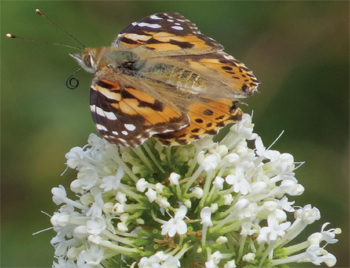| September
/ 2019 - Michael Ryan
|
Painted Lady feeding on Ragwort on Dalkey Hill
Image: M. Ryan
| When
mowing the grass I have to be careful to avoid the bees feeding on the
clover
growing on the lawn as some of them are so engrossed in their task they almost seem to be playing chicken, waiting until the very last second to fly out of the way. If they are slow to move I’d stop the mower but I hadn’t noticed one particular bumblebee till I saw it rolling around just inches away from where the machine had just passed. You would think there would be only one outcome if a bumblebee had a collision with a moving lawnmower but it must have only received a glancing blow as the bee, although stumbling around in a dazed and confused manner, didn’t seem too damaged. I carried it to a safer place where it seemed ok and when I checked later there was no sign of it so hopefully it had flown away. When I had first picked it up I’d noticed discarded on the grass two little yellow objects and recognised them as sacs of pollen that the impact had presumably knocked off the bee’s hind legs. These sacs are clearly visible on some queen and worker honey bees and bumblebees, like yellow or orange saddlebags attached to each rear leg and they are made up of the pollen the bee will have collected from flowers onto its body hairs which is then brushed back to a smooth area on their tibia which is surrounded by long stiff hairs forming a little space called a pollen basket or corbicula. The bees will be feeding on nectar from the plants which is ultimately turned into honey but the pollen that attaches to its body is gathered specifically to feed the emerging bee larvae in the hive. Bee pollen is considered one of the all-time great foods being a complete protein as well as being the only known food to contain all 22 amino acids that the human body needs but cannot produce for itself and apparently it contains more protein than any meat or fish. |
 Painted Lady on Valerian. Note the curled tongue Image: Michael Ryan |
 Bumblebee on an Antirrhinum. Note the pollen basket, or corbicula, attached to its hind leg. Image: Michael Ryan |
|
I was sorry for the bee that had lost it’s pollen sacs, each of
which can contain up to one million grains of pollen but at least it
survived the lawnmower collision to buzz another day and I got a unique
souvenir. We’d already noticed the large numbers of Painted Lady
butterflies and had even rescued one from a spider’s web in the
greenhouse before they made the news in early August, being discussed
on RTÉ’s paper review after featuring in the Irish Times.
Reports on wildlife in the media are frequently sensationalised but
this time the description of millions of them arriving in Ireland may
not have been exaggerated, especially since foremost Irish butterfly
expert Jesmond Harding had supported the claim. He’d actually
noticed large numbers of that species as far back as June and surmised
they may have moved farther north since the usual food plants of their
caterpillars in Europe hadn’t survived the extraordinary heat
wave that had covered huge areas of the continent for weeks. Surprisingly the big influx in August was first reported in Scotland and on our northern coast, an observer in Co. Down had over one hundred in his garden and they were described as being like a carpet on Tory Island off Donegal but subsequently they were seen all over the country. Painted Lady butterflies are summer migrants and though they originate in North Africa the individuals that arrive here are often from second generations that have been born in Spain and other Southern European countries before heading north, always in search of food plants to lay their eggs on. Although there are always individuals arriving in the summer large influxes usually occur every ten years so this year’s invasion was unusual as Jesmond said this was the fourth year in a row we’d had such a large number arrive. Jesmond, on his excellent website Butterfly Conservation Ireland (butterflyconservation.ie), predicts that if the weather remains warm there will be a later brood of Painted Lady hatching from the recent arrivals which should result in lots more on the wing in September. They have a great range of food plants and can appear anywhere. One local spot that should be good to see them is a particularly large buddleia bush on the middle level of Dalkey Quarry near the entrance from the car park. This particular bush attracts loads of insects, bees and hummingbird hawkmoths but it is particularly good for butterflies. We saw lots of Painted Ladies there in August as well as good numbers of Peacocks and Red Admirals. On the same day we counted at least a dozen on Creeping Thistle beside the aircraft beacon on the hill so that’s worth a look as well. Many of these Painted Lady butterflies hatched in the late summer will actually migrate back to North Africa. Previously Painted Ladies were a conundrum for naturalists and scientists since they presumed the cold-sensitive creatures died and their offspring wouldn’t survive the winter which seemed an odd evolutionary strategy. Unlike other species of butterfly nobody had witnessed them migrating back south until in 2009 researchers in the UK using radar monitored flocks of Painted Ladies flying at a altitude of 5oo metres. |
 |
Painted
Lady Image: M.
Ryan
DALKEY HOME PAGE | DALKEY COMMUNITY COUNCIL | DALKEY HERITAGE COMPANY | CANNONAID


